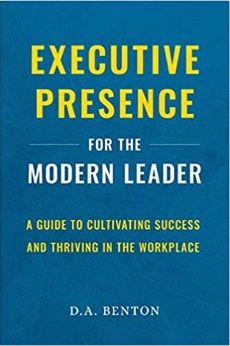Executive coach D.A. Benton – author of New York Times bestseller How To Think Like a CEO – details how you can develop executive presence.

Cool, Calm and Collected
New York Times bestseller and worldwide top-ten executive coach D.A. Benton’s thesis is that successful CEOs gain “executive presence from following an unwritten code of conduct or etiquette.” Few people speak about this code, she says, and those born into homes where they learn it as children grow up with an unfair advantage. Benton shares this code to help you realize your leadership dreams and ambitions. Whether you are beginning your leadership journey or already working in a corner office, Benton will help you make a strong impression, gain people’s trust and express yourself authentically.
Olga Selina, vice president of business operations at HERE, Inc., says, “Benton provides you with the tools and guidance to create a tailor-made executive presence that optimizes your strengths, helps you identify and minimize your weaknesses and bad habits, and learn from your failures.“ And Lisette Bergeron, vice president of Leidos, found that Benton offers, “a set of skills to develop and evolve, which empowers me to take full responsibility for the effect I have on others.”
Code of Conduct
Early in her career, Benton asked hundreds of CEOs why two people with similar ambitions, experience and intelligence might find different levels of success. Business leaders told her that the most successful people have executive presence; they follow an unwritten code that governs their behavior and interactions.
Those born into certain social or leadership circles learn the code at a young age, Benton reports, thus gaining an advantage that increases the likelihood that they will rise to the top. However, she is adamant you can learn the code and harness this advantage.
You’re smart, hardworking and honest. Shouldn’t that be enough for career success? Yes, it’s important to be those things, but it’s not sufficient. You also need to set yourself apart from other people who can say the same.D.A. Benton
Benton ardently urges you to observe the people you respect and be aware of how they elicit positive reactions. Benton asserts that those with executive presence are calm, confident, curious and competent; they act thoughtfully and strategically.
Leadership Style
Benton contends that there are six archetypes of leadership styles: visionaries, coaches, affiliative leaders, democratic executives, pacesetters and commanding leaders. She asserts that visionaries such as Elon Musk must project courage, self-assuredness and conviction. Coaches who help team members perform at their best must be active listeners and reliable. Affiliative leaders should display kindness. Democratic executives offer mutual respect and thoughtful decision-making. Pacesetters work harder than their employees and, Benton says, commanding leaders prefer traditional top-down leadership.
Emotional intelligence
Benton details how to cultivate self-awareness by learning to identify your emotional states and reflecting on your emotional triggers. She maintains you must develop knowledge of yourself so that you understand your feelings, values, motives, character, desires and habits.
The person working toward executive presence is slow to judge and treats people like they…want to be treated.D.A. Benton
Benton relates that emotionally intelligent leaders assume that other people have good intentions. These leaders don’t assume they’re smarter than other people, and they focus on their subordinates’ strengths. She characterizes these leaders as willing to embrace change and avoid negative thoughts. They don’t expect perfection from anyone – especially themselves.
Communication
Benton reminds you to speak – even when agitated or emotional – in the same tone of voice you’d use to ask someone to pass the salt.
With executive presence, communication is more than the words you say or type. It’s your tone when sending a message that calms or grates and the use of storytelling that helps you to be better understood as well as remembered and repeated.D. A. Benton
She wants you to tell stories to communicate various messages, including to underscore important points, explain a situation, reveal your actions and celebrate the outcome.
Body Language
Benton warns that, seconds after meeting you, people judge you as a leader. She suggests taking deep breaths and considering the presence you hope to exude, then use your body to express yourself: align your facial expression accordingly, hold your chin up and relax your shoulders. Make your movements purposeful, Benton advises, slow the pace of your speech to convey calmness and plan your approach before entering a room, rather than rushing into it.
Benton describes the desired non-invasive, attentive eye contact that executive presence demands. She says to watch a person’s nose or mouth from a distance, or alternate direct eye contact with glances in the air when gesturing or in thought. She wants you to be mindful of other people’s personal space and to turn your body slightly from theirs if you feel they’re invading yours.
Reputation
Benton reminds you that your image consists of both your self-image and how others perceive you.
Your goal is to consistently and deliberately conduct yourself in a way that makes you appear memorable, impressive, credible, genuine, trusted, liked, cool, calm, collected, confident and competent – because you are!D.A. Benton
Benton notes that your reputation determines your social position and reflects your degree of influence. People with a good reputation, she says, back up their words with actions and are courageous, honest, authentic and decisive.
To discover your authentic version of executive presence, Benton encourages you to embrace social norms to make others feel at ease, reflect on your values, draw inspiration from others, learn from your mistakes and always embrace learning.
A Primer
D.A. Benton has written several bestsellers and, in the process, she’s developed a glib, fast-moving, easy-to-read tone that relies on brief sentences and messages that would not look out of place in a PowerPoint display. In other words, she knows her audience, the brevity of their attention span and their preference for applicable slogans over deep thought. And Benton’s slogans are profoundly applicable. Her recommended behaviors are healthful and likely effective in achieving the goals she describes, which mostly consist of making others think better of you – not because you fool them, but because you help them improve. It would be hard to find a more apt or constructive description of executive presence than that.
D.A. Benton also wrote The Introvert’s Guide to Networking, The Leadership Mind Switch, Secrets of a CEO Coach and How To Think Like a CEO, among others.





